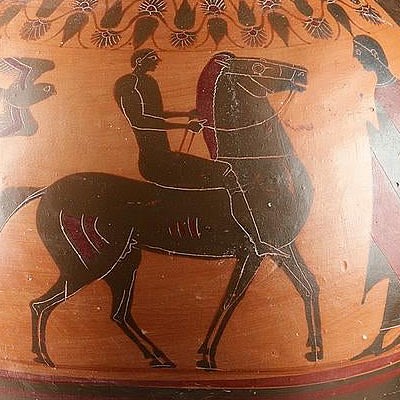Khmer Stone Carving w/ Two Devis and Man
Lot 118
About Seller
Artemis Fine Arts
686 S Taylor Ave, Ste 106
Louisville, CO 80027
United States
Selling antiquities, ancient and ethnographic art online since 1993, Artemis Gallery specializes in Classical Antiquities (Egyptian, Greek, Roman, Near Eastern), Asian, Pre-Columbian, African / Tribal / Oceanographic art. Our extensive inventory includes pottery, stone, metal, wood, glass and textil...Read more
Categories
Estimate:
$12,000 - $18,000
Absentee vs Live bid
Two ways to bid:
- Leave a max absentee bid and the platform will bid on your behalf up to your maximum bid during the live auction.
- Bid live during the auction and your bids will be submitted real-time to the auctioneer.
Bid Increments
| Price | Bid Increment |
|---|---|
| $0 | $25 |
| $300 | $50 |
| $1,000 | $100 |
| $2,000 | $250 |
| $5,000 | $500 |
| $10,000 | $1,000 |
| $20,000 | $2,500 |
| $50,000 | $5,000 |
| $100,000 | $10,000 |
| $200,000 | $20,000 |
About Auction
By Artemis Fine Arts
Jun 4, 2020
Set Reminder
2020-06-04 10:00:00
2020-06-04 10:00:00
America/New_York
Bidsquare
Bidsquare : Exceptional Antiquities, Asian, Ethnographic
https://www.bidsquare.com/auctions/artemis-gallery/exceptional-antiquities-asian-ethnographic-5185
An important one-day auction featuring museum-worthy examples of Egyptian, Greek, Roman, Etruscan, Near Eastern, Far East / Asian, Pre-Columbian, African / Tribal, Oceanic, Native American, Spanish Colonial, Russian, Fossils, Ancient Jewelry, Fine Art, so much more! Artemis Fine Arts info@artemisfinearts.com
An important one-day auction featuring museum-worthy examples of Egyptian, Greek, Roman, Etruscan, Near Eastern, Far East / Asian, Pre-Columbian, African / Tribal, Oceanic, Native American, Spanish Colonial, Russian, Fossils, Ancient Jewelry, Fine Art, so much more! Artemis Fine Arts info@artemisfinearts.com
- Lot Description
Southeast Asia, Khmer Empire, Suryavarman II period or earlier, ca. 12th century CE. A magnificently carved, brown-grey sandstone sculpture of a man - possibly the god Shiva - flanked by two smaller devi (also known as a devata or aspara), female goddesses found in Khmer temples. They stand atop an integral pedestal, with the women's hands resting gently on the buttocks of the man. Each woman wears a skirt (traditional Khmer clothing called a sampot) with tight pleats and a thick belt with ornate carving along with the preserved root marks that give the impression of embroidery, as well as large earrings and a headdress topped with a round bun - perhaps her hair is in the style known as bokor, the "hump of the bull", that is known from other Khmer statues. Each has a face that is classically Khmer, expressive and sensual, with pronounced lips. Size: 6.5" L x 18" W x 26" H (16.5 cm x 45.7 cm x 66 cm)
The man wears a similar belted garment at his waist, though this one is short. He has a youthful body, with arms tilted upward that likely once held an implement, and a lifelike face with a large headdress and column rising from the top of his head.
Khmer art moved away from Indian styles in the 7th century CE to encompass its own framework; one example of this seen here is that this statue is carved in the round, rather than as a relief on a stela, which was common with Indian and Javanese Hindu and Buddhist sculptures that previously influenced Cambodian art. The broken arms on this statue, and on so many others from the Khmer, are a testament to the fragility of this remarkable craftsmanship. From this, we can infer that Khmer sculptors would have desired their artwork to be viewed from all sides, and thus placed in the center of temples rather than against a wall.
Depictions of devi were made by the Khmer to show the highest level of beauty - each with her small, round breasts, large eyes and mouth, long earlobes, and youthful body would have all been ideals. However, we believe that these idealized statues were also based, by the 12th century and probably before, on real people at the Khmer court - hence the beautiful clothing and jewelry all wear. A class of court artisans, supervised by priests, created each figure individually. The Khmer loved to represent women in their sculptural art - Angkor Wat, for example, which was built by Suryavarman II, contains carvings of 1,796 women. Recent facial analysis of the carvings by archaeologists suggest that they represent real women.
Provenance: private Orange County, California, USA collection, acquired in the 1930s
All items legal to buy/sell under U.S. Statute covering cultural patrimony Code 2600, CHAPTER 14, and are guaranteed to be as described or your money back.
A Certificate of Authenticity will accompany all winning bids.
We ship worldwide and handle all shipping in-house for your convenience.
#155853Repaired and restored from multiple pieces, with repairs at the legs, arms, and other joints. These are well done and largely unobtrusive. Small loss from front of pedestal. Tiny chips, nicks, and other tiny losses commensurate with age.Condition
- Shipping Info
-
All shipping is handled in-house for your convenience. Your invoice from Artemis Gallery will include shipping calculation instructions. If in doubt, please inquire BEFORE bidding for estimated shipping costs for individual items.
-
- Buyer's Premium



 EUR
EUR CAD
CAD AUD
AUD GBP
GBP MXN
MXN HKD
HKD CNY
CNY MYR
MYR SEK
SEK SGD
SGD CHF
CHF THB
THB















